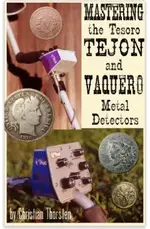- Joined
- May 28, 2010
- Messages
- 20,279
- Reaction score
- 32,199
- Golden Thread
- 1
- Location
- White Plains, New York
- 🥇 Banner finds
- 1
- 🏆 Honorable Mentions:
- 1
- Detector(s) used
- Nokta Makro Legend// Pulsedive// Minelab GPZ 7000// Vanquish 540// Minelab Pro Find 35// Dune Kraken Sandscoop// Grave Digger Tools Tombstone shovel & Sidekick digger// Bunk's Hermit Pick
- Primary Interest:
- Metal Detecting
- #1
Thread Owner
“Mastering the Tesoro Tejón and Vaquero Metal Detectors,” by Christian Thorsten / Kindle E-Book / Amazon.com / $9.99
A lot of folks ask why anyone would write an advanced user manual for machines that are over a decade old. Author Christian Thorsten answers that question this way – “The first answer is that they're worth it. I don't know of any other book that concentrates on these two models.” A simple, straight forward, easy to understand answer that mirror’s the author’s writing style.
Chris writes in detail about the more advanced use of the two machines and how to dig deeper targets while digging less trash. Topics include Depth finding; Discrimination; Ground balancing; Working in iron; Digging deep coins; One tone audio; and The “round” signal.
Chris explains, “..There's another type of information you can gather from the single audio tone of the Vaquero or Tejón. Conductive, round objects can give what I'd call a "round signal". With a couple of the right attributes (such as apparent signal width), this round signal can become a sort of "coin signature" that allows you to pick out desirable targets from junk.”
He goes on to describe more complex signal characteristics like duration, volume, rise and fall profile, hard-edged, soft-edged, broken, smooth, loud, soft, solid, clipped, drawn-out and narrow signals and, what they mean. Many of the nuances in a single-tone signal took me hundreds-of-hours on the headphones to learn and understand on my own. This book can help you cut your learning time on the headphones by months, maybe years!
Another thing I really enjoyed about the book was the honest and empirical comparisons made between multi-frequency and multi-tone machines, to the Vaquero and Tejón. Chris writes, “One tone or multi tones? Which is better in the field? In my experience, much of the contest happens at the highly trash-infested sites, where there are junk targets everywhere. The two technologies have different approaches toward these junk targets.” Want to know which one he chooses and why? Buy the book!
Lastly, like many old codgers who went without computers until our grandchildren insisted we try one, I was a bit dubious about “downloading” a book. Fortunately for all of us, it could not be easier! I had to download the free Kindle app to my computer so that I could read the book (you can also put it on your telephone), purchase the book at Amazon, and I was in business. I was even able to print it out at home!
If you own a Tesoro Tejón, Vaquero, Outlaw or Cibola, you should read this book. It is gold and silver in your finds bag! – Terry Soloman http://www.TerryrSoloman.com
https://www.amazon.com/Mastering-Te...tors-ebook/dp/B00GN27CTQ?tag=treasurenet01-20
A lot of folks ask why anyone would write an advanced user manual for machines that are over a decade old. Author Christian Thorsten answers that question this way – “The first answer is that they're worth it. I don't know of any other book that concentrates on these two models.” A simple, straight forward, easy to understand answer that mirror’s the author’s writing style.
Chris writes in detail about the more advanced use of the two machines and how to dig deeper targets while digging less trash. Topics include Depth finding; Discrimination; Ground balancing; Working in iron; Digging deep coins; One tone audio; and The “round” signal.
Chris explains, “..There's another type of information you can gather from the single audio tone of the Vaquero or Tejón. Conductive, round objects can give what I'd call a "round signal". With a couple of the right attributes (such as apparent signal width), this round signal can become a sort of "coin signature" that allows you to pick out desirable targets from junk.”
He goes on to describe more complex signal characteristics like duration, volume, rise and fall profile, hard-edged, soft-edged, broken, smooth, loud, soft, solid, clipped, drawn-out and narrow signals and, what they mean. Many of the nuances in a single-tone signal took me hundreds-of-hours on the headphones to learn and understand on my own. This book can help you cut your learning time on the headphones by months, maybe years!
Another thing I really enjoyed about the book was the honest and empirical comparisons made between multi-frequency and multi-tone machines, to the Vaquero and Tejón. Chris writes, “One tone or multi tones? Which is better in the field? In my experience, much of the contest happens at the highly trash-infested sites, where there are junk targets everywhere. The two technologies have different approaches toward these junk targets.” Want to know which one he chooses and why? Buy the book!
Lastly, like many old codgers who went without computers until our grandchildren insisted we try one, I was a bit dubious about “downloading” a book. Fortunately for all of us, it could not be easier! I had to download the free Kindle app to my computer so that I could read the book (you can also put it on your telephone), purchase the book at Amazon, and I was in business. I was even able to print it out at home!
If you own a Tesoro Tejón, Vaquero, Outlaw or Cibola, you should read this book. It is gold and silver in your finds bag! – Terry Soloman http://www.TerryrSoloman.com
https://www.amazon.com/Mastering-Te...tors-ebook/dp/B00GN27CTQ?tag=treasurenet01-20





